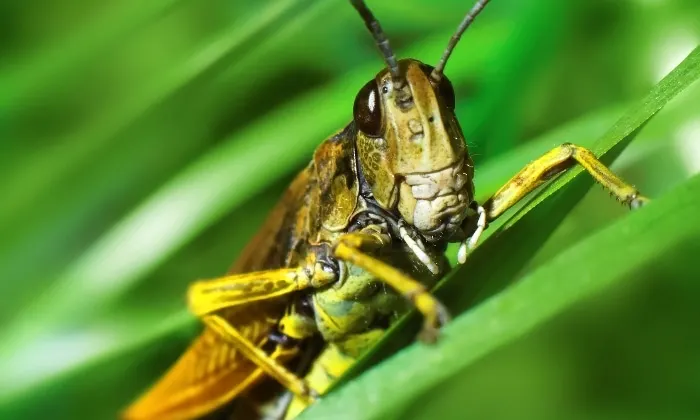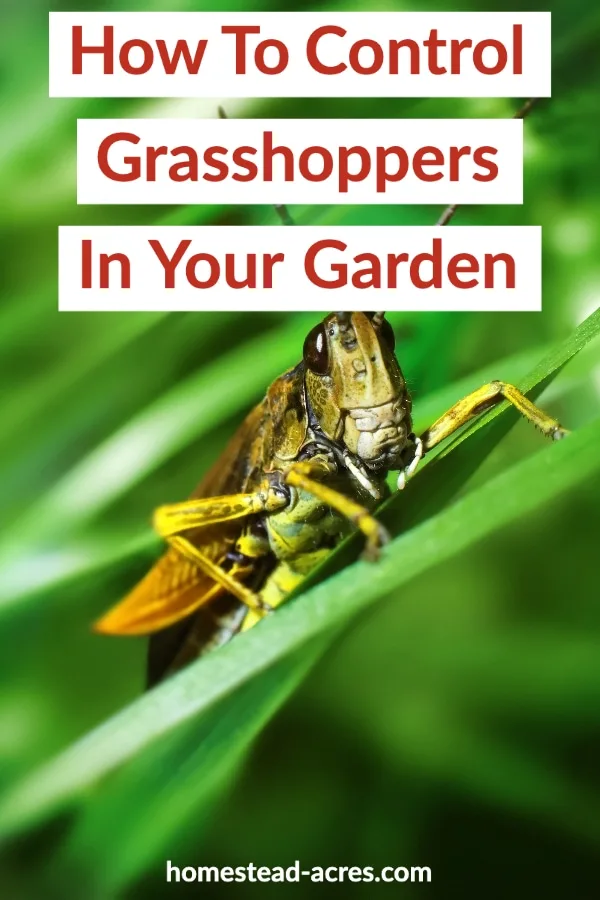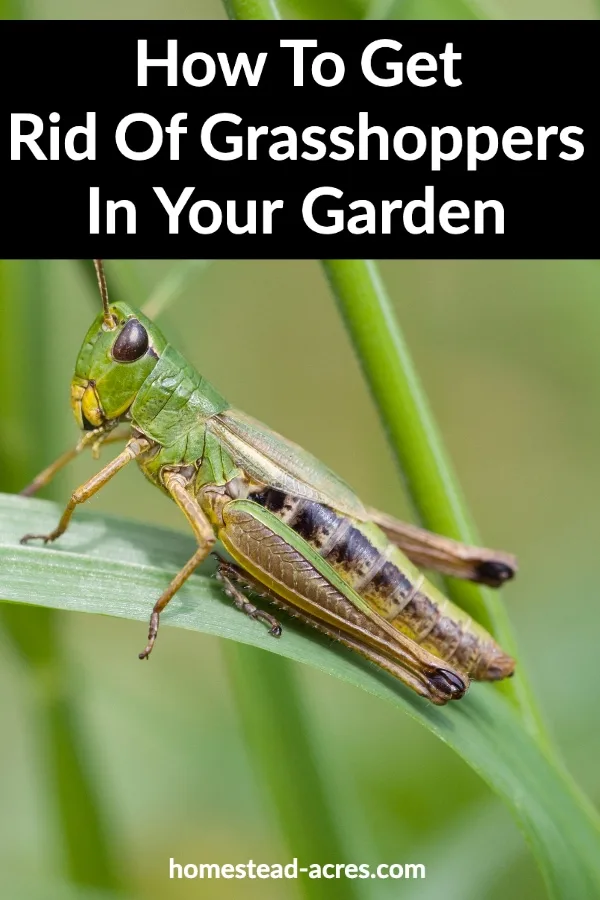This post may contain affiliate links, my full disclosure can be read here. As an Amazon Associate I earn from qualifying purchases.
Wondering how to get rid of grasshoppers in your garden?
Grasshoppers are a common pest found throughout the world. When their numbers get too high they can pose a real problem to your plants. The good news is they can be controlled with natural methods such as diatomaceous earth, neem oil, and natural predators.
Let’s take a look at grasshoppers more closely and see if they are a pest you need to deal with or not.
North American has about 600 species of grasshoppers.
But only a small number of these cause significant damage to crops.
Even in the smaller group, their numbers have to be quite large to cause a lot of damage.

Grasshoppers provide a natural food source to many other insects and animals including spiders, snakes, lizards, birds, and toads.
If you are only seeing a few grasshoppers in your garden there is no need to start going after them heavily.
However, using more gentle prevention measures suggested below such as row covers, and attracting natural predictors is always a good idea.
Identification

Adult grasshoppers are green to brown in color and can grow as long as 1 3/4 inches (4.44 cm). They have narrow bodies with long, angled hind legs. These legs give them a powerful jumping ability.
They have large heads with big eyes and large chewing mouths. The adults also have wings and can be seen flying in your garden.
While young grasshoppers are similar in appearance, they don’t have wings and are white in color when they first hatch.
Lifecycle
For two weeks after breeding grasshoppers lay their eggs in the soil near the end of summer.
The female digs a hole in the dirt and then lays a cluster of eggs that she then covers in a foamy secretion that hardens to form a pod.
The number of eggs laid at once can range from 8 to 150. They start to develop in their pod as long as the temperatures say above 50 F (10 C). When the weather becomes too cold they go dormant over the winter and will finish growing in the spring.
Right after hatching (normally early May to mid-June) the grasshopper nymphs start eating plants. As they grow and run out of food in the area they hatched they start to spread into new areas.
When they first hatch the baby grasshoppers or nymphs are 0.2 inches (5 mm) in size and look a lot like an adult grasshopper except they don’t have wings.
It takes about 2 months for grasshoppers to reach their adult stage. But either way, they will keep eating heavily each day until they are killed by the cold of winter.
When populations become high the stress can cause some grasshopper species to undergo changes to their bodies.
They change in color and start to form swarms. When this happens they are called locusts.
Damage – What Do Grasshoppers Eat?

Grasshoppers normally prefer young, tender leaves and stems on vegetable plants, grass, and flowers. But when their numbers are high they have more competition for food and will eat almost anything.
Their damage causes large holes in both flowers and leaves. They can eat young plants right to the ground.
Grasshopper damage normally starts on the edge of the leaves.
Grasshoppers feed on many different plants including vegetables like lettuce, corn, beans, carrots, and onions.
For field crops, they will eat soybeans, alfalfa, clover, rice, cotton, tobacco, and grasses. This makes them a common pest for both home gardeners and farmers alike.
While these may be their favorite foods in peak years when grasshopper infestations happen they are much less picky and will eat just about any plant.
How To Get Rid Of Grasshoppers

There are many grasshopper control methods you can use if this insect start to cause too much damage in your garden. These are the methods we have had the most success with in our gardens.
1. Use Row Covers
If you don’t already have grasshoppers in your garden you can keep it that way by covering your plants with row covers.
This should be done as soon as you transplant them into your garden. Make sure to use hoops to keep the fabric off the plants so pests don’t try to feed right through it.
Row covers come in many different types. In this case, you’ll want to use a fine bug netting.
2. Diatomaceous Earth (DE)
Diatomaceous earth is a very effective way of controlling pests in your vegetable garden. It’s made up of tiny fossilized shells.
When insects like grasshoppers come into contact with DE it causes them to dry out.
Make sure to only use food grade diatomaceous earth in your garden. Simply sprinkle it over your plants and on the ground around them to keep pests away.
3. Neem Oil
Neem oil is a popular organic pesticide and fungicide for organic gardeners.
While it might not directly kill grasshoppers it can work as a repellant. Insects often don’t like the taste of the oil.
Also, neem oil affects the reproduction of insects, deters them from laying eggs and slows growth. This can help lower the population of grasshoppers in your garden the following year.
4. Guinea Fowl
Guinea fowl are wonderful birds to keep if you have pests in your garden and they love to eat grasshoppers.
Unlike chickens, they don’t scratch the dirt and won’t harm your garden nearly as much. In return the will eat a lot of ticks, grasshoppers and other pests that drive you crazy.
5. Early Planting
Simply planting your garden earlier can help you slow down the damage caused by grasshoppers. Grasshoppers do prefer young, tender foliage to eat. It’s not that they won’t eat more mature plants but will choose younger ones if they have a choice.
The plants are more established have a better chance of surviving an attack and it can reduce the amount of damage to your plants.
6. Natural Predators
Grasshoppers have many natural predators that feed on both the eggs and adults.
Blister beetles, crickets and ground beetles are the main predators that feed on grasshopper eggs.
The common field cricket can eat up to 50% of grasshopper eggs in some areas. While with other predators it’s their larva that feeds on the grasshopper eggs.
The larva of blister beetles and bee flies find the eg pods and eat the eggs. If you have a high population of bee flies or blister beetles they can eat up to 80% of grasshopper eggs.
As for predators of nymph and adult grasshoppers, spiders, birds, wasps, praying mantis, snakes and toads, and robber flies can eat large numbers of this pest.
Grasshopper infestations often come in multi-year cycles. So if you’ve had a lot of grasshoppers this year, there is a good chance you will again next year.
So start using preventative measures early in the growing season. But don’t worry the problem will slowly decline over time.
How To Get Rid Of Grasshoppers In Your Garden
Equipment
Materials
- Bug netting
- Diatomaceous earth optional
- Neem oil optional
Instructions
- Use row covers starting early in the growing season to keep grasshoppers off your plants. A lightweight bug netting is the best to use. Just remember to suspend it over your plants using hoops. This will keep insects from chewing or laying eggs through the cloth.
- Diatomaceous earth is another way to control grasshoppers that works well. Sprinkle food-grade DE over your plants and around the base to keep pests away. It will dry out and kill many insects but often they will avoid plants that it’s on as it feels abrasive to them.
- Neem oil helps to repel grasshoppers when you spray it on your plant leaves. Grasshoppers and other insects dislike the taste of this natural oil. It also interferes with their reproduction helping to deter them from laying eggs.
- Keeping a small flock of guinea fowl can really help to lower your pest problem. Unlike chickens, guinea hens don’t scratch up your garden soil.
- Encourage natural predators in your garden. Grasshoppers have many natural predators such as chickens, ground beetles, spiders, wasps, toads, and snakes.
- Another way to lower grasshopper problems is to simply plant your garden earlier than normal. This can help your plants be more mature when the grasshoppers arrive and gives them a better chance of surviving the damage.
Connect With Homestead Acres!
Be sure to follow me on social media, so you never miss a post!
Facebook | Twitter | Pinterest | Twitter
Visit my Amazon store to find all my favorite gardening, homesteading tools, and gadgets plus all of my printed garden books and journals!

Kim Mills is a homeschooling mom of 6 and lives on an urban homestead in Ontario, Canada. Blogging at Homestead Acres she enjoys sharing tips to help you save money, grow and preserve your own food.



